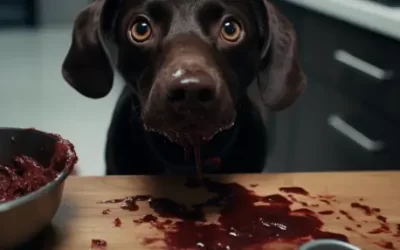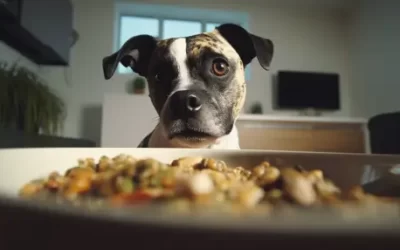Pet owners often find themselves with questions that stem from genuine concerns for their furry companions. One common query revolves around the curiosity-inducing scenario: Can dogs eat helicopter seeds? It’s a question that reflects a deep-seated desire for the well-being of our canine friends, a quest for information that goes beyond the surface and delves into the intricacies of responsible pet ownership.
As a seasoned veterinary professional, I empathize with the genuine care and curiosity that prompt such inquiries, and it’s precisely this empathy that fuels the comprehensive exploration we’re about to embark on.
In my years of experience in the field of veterinary medicine, I’ve encountered a myriad of questions surrounding pet nutrition and potential hazards in their environments. The question of dogs consuming helicopter seeds is one that requires a nuanced understanding of both botanical elements and canine physiology.
If you’re seeking a comprehensive and reliable answer to the question of whether dogs can eat helicopter seeds, you’re in the right place. This article is more than a source of information; it’s a tailored guide crafted with a caring, engaging, and informative tone.
Dogs should not eat helicopter seeds, also known as maple seeds. While these seeds themselves are not toxic, they can pose a choking hazard or cause digestive issues if ingested by dogs. Additionally, the outer coating of the seed contains substances that may cause irritation.
- Understanding Helicopter Seeds
- Dogs and Their Dietary Needs
- Potential Risks of Dogs Eating Helicopter Seeds
- Safe vs. Unsafe Maple Seeds for Dogs
- Signs of Seed Ingestion and Monitoring Your Dog
- Alternatives for Safe Treats and Snacks
- Final Thoughts: Can Dogs Eat Helicopter Seeds?
- Frequently Asked Questions on Feeding Dog Helicopter Seeds?
Understanding Helicopter Seeds

Helicopter seeds, those twirling wonders that dance in the wind during fall, often capture our attention.
As a veterinary professional with years of experience, let’s delve into a comprehensive understanding of these seeds and address the pressing question: Can dogs safely eat helicopter seeds?
Helicopter Seeds and their Common Sources (Maple Trees)
Helicopter seeds, scientifically known as samaras, are the winged seeds produced by various species of maple trees.
These trees are prevalent in many regions, and their seeds are characterized by a distinctive wing-like structure that enables them to spiral gracefully to the ground.
The seeds typically consist of a central pod housing the embryonic plant and two wing-like structures extending outward. The most common maple trees that produce these helicopter seeds include the sugar maple, silver maple, and Norway maple.
The Purpose of the Wing-Like Structure in Seed Dispersal
Nature equips these seeds with their unique aerial ballet for a specific reason – efficient seed dispersal. The wing-like structures facilitate a slow descent, allowing the seeds to cover a larger area as they travel with the wind.
This mechanism increases the chances of the seeds finding suitable conditions for germination and growth, contributing to the survival and proliferation of maple tree species.
While this adaptation is fascinating from a botanical perspective, it raises concerns when it comes to our canine companions.
Nutritional Composition of Helicopter Seeds
From a nutritional standpoint, helicopter seeds are not a significant source of sustenance. They primarily consist of a protective outer shell and a small, nutrient-packed pod housing the potential plant.
While they may contain trace elements, they are not a staple in a dog’s diet. It’s crucial for pet owners to understand that dogs have specific dietary requirements, and incorporating helicopter seeds into their meals is neither necessary nor recommended.
In the following sections, we’ll explore the potential risks associated with dogs consuming these seeds and provide guidance on ensuring the well-being of our furry friends.
Also Read: Can Dogs Eat Zucchini Seeds?
Dogs and Their Dietary Needs

Understanding the dietary needs of our canine companions is paramount for responsible pet ownership.
As a seasoned veterinary professional, let’s explore the intricacies of a typical dog’s diet and the considerations crucial for maintaining their health and well-being.
Typical Dog’s Diet
Dogs, by nature, are omnivores with dietary requirements that differ from their human counterparts. A balanced canine diet typically consists of a combination of proteins, fats, carbohydrates, vitamins, and minerals.
Proteins, sourced from meat or plant-based alternatives, are essential for muscle development, while fats provide energy and support overall health.
Carbohydrates, derived from grains and vegetables, contribute to energy levels, and a spectrum of vitamins and minerals aids in various physiological functions. Understanding these components is fundamental to providing a diet that meets a dog’s nutritional needs.
Factors to Consider When Introducing New Foods to a Dog’s Diet
Introducing new foods to a dog’s diet requires careful consideration. Dogs may have sensitivities or allergies to certain ingredients, emphasizing the importance of gradual and monitored introductions. Monitoring for adverse reactions, such as digestive upset or allergic responses, is crucial.
Additionally, the size, age, and health condition of the dog play pivotal roles in determining dietary requirements.
Veterinary guidance is invaluable when contemplating diet changes, ensuring that the transition aligns with the individual needs of each furry companion.
The Importance of a Balanced and Nutritionally Complete Diet for Dogs
Maintaining a balanced and nutritionally complete diet is the cornerstone of canine health. Each nutrient plays a specific role in supporting bodily functions, and deficiencies or imbalances can lead to a spectrum of health issues.
A balanced diet not only supports a dog’s overall well-being but also enhances their immune system, promotes healthy coat and skin, and aids in proper growth and development.
Pet owners should be discerning in selecting commercial dog foods or preparing homemade meals, ensuring that the chosen diet aligns with the specific nutritional needs of their canine companions.
Also Read: Can Dogs Eat Maple Tree Seeds?
Potential Risks of Dogs Eating Helicopter Seeds

While the allure of helicopter seeds during the fall season is undeniable, it’s crucial for dog owners to be aware of potential risks associated with their pets consuming these botanical wonders.
As a veterinarian with extensive experience, let’s delve into the specific hazards that helicopter seeds may pose to our canine companions.
Toxic Components in Helicopter Seeds
Helicopter seeds, despite their enchanting appearance, can harbor toxic components that may adversely affect dogs. Understanding these potential dangers is vital for safeguarding the well-being of our furry friends.
Presence of Chemicals Harmful to Dogs
Helicopter seeds contain substances that can be harmful to dogs, especially when ingested in larger quantities.
One notable concern is the presence of tannins, which are naturally occurring compounds in certain plants.
Ingesting high amounts of tannins may lead to gastrointestinal upset, including symptoms like vomiting, diarrhea, and abdominal discomfort. It’s essential for dog owners to be vigilant and prevent excessive consumption of these seeds, particularly in areas where they are abundant.
Specific Types of Maple Trees to Be Cautious Of
Not all maple trees are created equal, and some species pose greater risks than others. The sugar maple, silver maple, and Norway maple are known to produce helicopter seeds and may contain varying levels of potentially harmful substances.
Dog owners should be particularly cautious in environments where these specific types of maple trees are prevalent.
Recognizing and avoiding areas with a high concentration of these trees can reduce the likelihood of dogs coming into contact with and consuming helicopter seeds.
Common Symptoms of Seed Ingestion in Dogs
The ingestion of helicopter seeds can lead to noticeable symptoms in dogs. These may include immediate signs of distress, such as vomiting, diarrhea, and abdominal discomfort.
In some cases, dogs may exhibit lethargy or a lack of appetite. It’s crucial for pet owners to be attuned to these signs and seek prompt veterinary attention if any concerning symptoms arise.
Potential Long-Term Effects on a Dog’s Health
While acute symptoms may manifest shortly after ingestion, there can also be potential long-term effects on a dog’s health.
Chronic exposure to certain compounds in helicopter seeds may contribute to more serious health issues, impacting organ function or overall well-being.
Monitoring a dog’s health and seeking veterinary advice if any long-term concerns arise is imperative for proactive and preventative care.
Also Read: Can Dogs Eat Maple Seeds?
Safe vs. Unsafe Maple Seeds for Dogs

Discerning between safe and unsafe maple seeds is a crucial skill for dog owners who want to ensure the well-being of their furry companions.
As a seasoned veterinary professional, let’s explore how to identify these seeds and implement preventive measures in areas frequented by our canine friends.
Safe and Unsafe Maple Seeds
Distinguishing between safe and unsafe maple seeds is pivotal for mitigating potential risks to dogs. Safe seeds are typically those from non-toxic maple varieties, while unsafe seeds may come from trees containing harmful substances.
The sugar maple, silver maple, and Norway maple are common maple trees that produce helicopter seeds, but not all seeds from these trees pose the same level of risk.
It’s essential to recognize the specific characteristics of safe seeds and exercise caution in environments where potentially harmful seeds may be present.
Distinguish Between Different Types of Maple Seeds
Visual identification is a valuable skill for dog owners seeking to differentiate between various types of maple seeds.
Safe seeds often have distinct features, such as a well-formed wing structure and a characteristic color. Unsafe seeds may exhibit irregularities, discolorations, or a lack of the typical helicopter-like design.
By familiarizing themselves with these visual cues, dog owners can make informed decisions when allowing their pets to roam in areas where maple seeds are prevalent.
Avoiding Harmful Seeds in Areas Where Dogs Play or Walk
Prevention is key when it comes to safeguarding dogs from potential hazards associated with maple seeds.
Dog owners can take proactive measures to minimize the risk of seed ingestion by choosing play areas wisely. Avoiding locations with an abundance of specific maple trees known to produce harmful seeds is a fundamental step.
Regularly inspecting play areas for fallen seeds and promptly removing any potentially harmful debris can further reduce the risk of dogs coming into contact with unsafe maple seeds.
Also Read: Can Dogs Eat Jimmy Dean Sausage?
Signs of Seed Ingestion and Monitoring Your Dog

As vigilant pet owners, recognizing the signs of seed ingestion in our canine companions is crucial for their well-being.
In this section, we’ll explore behavioral changes, symptoms of discomfort, and the importance of regular monitoring and veterinary check-ups following the ingestion of helicopter seeds.
Behavioral Changes Indicating Seed Consumption
Detecting subtle behavioral changes is often the first step in identifying whether a dog has consumed helicopter seeds.
Watch for alterations in eating habits, such as a decrease in appetite or an aversion to regular meals. Changes in activity levels, such as lethargy or restlessness, may also indicate discomfort.
Pawing at the mouth or excessive salivation can be signs that a dog has ingested something unusual. Pet owners who notice such behavioral shifts should investigate further and seek veterinary guidance if necessary.
Symptoms of Discomfort or Toxicity
Symptoms of discomfort or toxicity may manifest more prominently and can include gastrointestinal distress such as vomiting or diarrhea.
Abdominal discomfort, manifested through whining or reluctance to be touched around the belly, is also a potential indicator. In severe cases, dogs may exhibit neurological symptoms, such as tremors or seizures, signaling a more urgent need for veterinary attention.
Being attuned to these symptoms is crucial for prompt intervention and ensuring the best possible outcome for the dog’s health.
Importance of Regular Monitoring and Veterinary Check-ups
Regular monitoring of a dog’s health is a responsibility that extends beyond immediate concerns. After potential seed ingestion, consistent observation is essential to identify any delayed reactions or lingering symptoms.
Additionally, scheduling regular veterinary check-ups is advisable to assess overall health and address any concerns proactively.
Veterinarians can conduct thorough examinations, recommend appropriate diagnostic tests, and provide guidance on potential interventions or treatments if necessary.
Also Read: Can Dogs Eat Liver Sausage?
Alternatives for Safe Treats and Snacks

Ensuring that our canine companions enjoy a diet rich in safe and delectable treats is a cornerstone of responsible pet ownership.
In this section, we’ll explore a diverse array of dog-friendly treats and snacks, including both commercial options and homemade alternatives that prioritize your furry friend’s well-being.
List of Dog-Friendly Treats and Snacks
When it comes to choosing treats for your dog, a variety of commercial options are available that prioritize both taste and nutritional value. Consider including these in your furry friend’s treat repertoire:
- Lean Meat Treats: Such as turkey or chicken jerky.
- Vegetable Bites: Carrot or sweet potato slices can be excellent crunchy options.
- Fruit Delights: Small portions of dog-safe fruits like apple slices or blueberries.
- Dental Chews: Not only tasty but also beneficial for oral health.
- Freeze-Dried Treats: Maintaining the nutritional value while providing a unique texture.
Homemade Alternatives that are Safe and Enjoyable for Dogs
For those who prefer a hands-on approach to their dog’s treats, consider crafting these homemade alternatives:
- Peanut Butter Biscuits: A classic and well-loved option.
- Frozen Yogurt Drops: A refreshing and simple summer treat.
- Pumpkin Pupsicles: Combining the goodness of pumpkin with a cooling element.
- Oat and Banana Bites: A blend of fiber and natural sweetness.
- Chicken and Sweet Potato Jerky: A homemade twist on a canine favorite.
Promoting a Healthy and Varied Diet for Dogs
While treats and snacks are delightful, it’s crucial to integrate them into a broader framework of a healthy and varied diet.
Dogs, like humans, benefit from diversity in their meals. This includes a balance of proteins, fats, carbohydrates, vitamins, and minerals.
Pet owners should consult with veterinarians to tailor a diet that aligns with their dog’s specific needs, considering factors such as age, size, and health condition.
Also Read: Can Dogs Eat Blood Sausage?
Final Thoughts: Can Dogs Eat Helicopter Seeds?

It is not advisable for dogs to eat helicopter seeds. These seeds, produced by various species of maple trees, can pose potential risks to dogs due to the presence of toxic components, such as tannins.
Ingesting helicopter seeds may lead to gastrointestinal upset, including vomiting and diarrhea. Additionally, specific types of maple trees, such as the sugar maple, silver maple, and Norway maple, are known to produce these seeds and may contain varying levels of harmful substances.
To ensure the safety of your canine companion, it’s best to prevent them from consuming helicopter seeds and, if ingestion is suspected, seek prompt veterinary attention.
Key Points Regarding Dogs and Helicopter Seeds
In this journey through the nuances of dogs and helicopter seeds, we’ve uncovered the potential risks associated with these whimsical seeds.
Recognizing the toxic components, understanding the behavioral signs of seed ingestion, and differentiating between safe and unsafe seeds are pivotal aspects for dog owners.
Balancing our curiosity about the natural world with a commitment to our pets’ well-being ensures a harmonious coexistence with the environment.
The Importance of Responsible Pet Ownership and Dietary Choices
The health and happiness of our dogs rest on the foundations of responsible pet ownership. Providing a balanced, nutritionally complete diet that aligns with their specific needs is a fundamental aspect of this responsibility.
Beyond the immediate risks associated with helicopter seeds, this exploration serves as a reminder to be mindful of our pets’ dietary choices in various contexts. By making informed decisions, we contribute to their overall health and longevity.
Readers to Consult with a Veterinarian for Personalized Advice
While this article provides valuable insights, each dog is unique, and individual factors may influence their dietary requirements.
Encouraging readers to consult with a veterinarian for personalized advice is the cornerstone of responsible pet care. Veterinarians possess the expertise to tailor recommendations based on a dog’s age, size, health condition, and specific needs.
This collaborative approach ensures that the information presented here serves as a foundation, complemented by the expertise of veterinary professionals.









